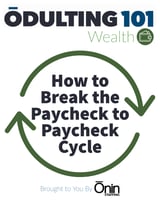If you’re like most people (64% of Americans as of February 2022), you’re probably living...
Figuring Out How to Invest Money on a Tight Budget
If you’re like most people, you’re always looking for ways to save money. But what if you could save money and invest at the same time? It may sound too good to be true, but it’s not, even if you’re living paycheck to paycheck. You just need to know where to look. Here is some information to help you start your journey toward financial literacy around investing.
Get Your Finances In Order
As a beginner, all of the experts agree that there are a few things you should do before you start putting your money into the market. First, you need to get your finances in order. This means knowing how much money you have coming in each month and how much you have going out. Once you have a good understanding of your cash flow, you can start to look at investing as an option for growing your wealth. If you have credit card or other debt, your wisest investment will be to pay that off first – the interest you pay on debt will always grow faster than returns you’d get from the stock market.
When you’re ready to start investing, be sure to do your research and work with a financial advisor to ensure that you’re making the best decisions for your future. With a little preparation and knowledge, you can be on your way to reaching your financial goals.
Simple Ways To Start Investing
If this is your first time investing, you may be wondering how to get started without breaking the bank. The good news is that there are plenty of simple ways to start investing even on a tight budget. One of the easiest ways to get started is to invest in your company’s 401(k) retirement plan, if they offer one. In fact, if your employer offers a matching plan (where your employer will match your contribution dollar-for-dollar up to a certain percentage of your salary), then it’s worth investing in even if you do have debt, for two reasons. First, if your employer matches, then that’s an automatic 100% return on your investment. You double your money right out of the gate, and that return is going to dwarf the interest rate of any debt you may carry. Second, even though it is being invested long-term, it is still your money, which means you are getting an instant raise, likely in the 3%-6% range depending on your employer’s match.
In a 401(k), you are typically investing in a mutual fund. With a mutual fund, you can pool your money with other investors and spread the risk across a diversified portfolio of stocks and bonds. Another option is to invest in exchange-traded funds, which offer a similar structure but tend to be lower in fees. Trading in individual stocks can be effective, and you can choose to only invest in business you like and want to support… but they are often riskier and more volatile.
Choose The Right Investment For You
It’s important to choose an investment that’s right for you. There are many factors to consider, such as your financial goals, your risk tolerance, and your investment timeline. If you’re not sure where to start, there are plenty of resources available to help you research different investment options and find the one that best suits your needs. Once you’ve found an investment that meets your criteria, it’s important to stay disciplined and stick to your plan. Even if the market turns sour or your investment loses value in the short-term, remember that you’re investing for the long haul. If you stay the course, you’re more likely to reach your financial goals.
Diversify Your Portfolio
It can be difficult to know where to start. Keep in mind that this article isn’t intended to be taken as financial advice itself, but simply information intended to give you a nudge in the right direction as you begin your journey into financial literacy.
However, there are a few general guidelines that can help you begin that journey of discovery. If you’re working with a tight budget, for example, you might want to consider reading about index funds or balanced mutual funds. These options offer a diversified portfolio with low fees and expenses, making them a good choice for beginning investors. If you’re willing to take on more risk, however, you might want to consider looking at individual stocks or sector-specific ETFs. These options can offer the potential for higher returns, but they also come with greater risks. Ultimately, the best investment for you will depend on your financial goals and your tolerance for risk.
Monitor Your Investments
You don’t get a second chance to make a first impression, or so the saying goes. The same could be said of investing. As you begin investing, it’s important to monitor your investments closely. Doing so will help you to identify any potential problems early on and take corrective action if necessary. It will also give you a better understanding of how your investments are performing and whether or not they are meeting your expectations. Of course, monitoring your investments is no guarantee of success, but it is an important part of the process. So as you begin your investment journey, remember to keep an eye on your portfolios and make adjustments as needed.
Rebalance Your Portfolio As Needed
As you learn more and gain confidence in investing, you will inevitably make some mistakes. That’s okay! As they say, “you live and you learn.” However, one mistake that you don’t want to make is failing to rebalance your portfolio as needed. Just as your life changes over time, so do your investment needs. As your circumstances change, it is important to reassess your risk tolerance and adjust your portfolio accordingly. For example, if you get married or have children, you may want to shift some of your assets into less volatile investments. On the other hand, if you experience a major life event like a divorce or job loss, you may need to take on more risk in order to achieve your financial goals. Also, over time, mutual funds and other investment vehicles evolve, dropping and adding the companies that are included. The bottom line is that rebalancing your portfolio is an essential part of successful investing. So don’t be afraid to make changes as needed – it could make all the difference in achieving your financial goals.
Stay Disciplined With Your Spending Habits
When you have the ability to make informed decisions about where to put your money, you’re less likely to waste it on unnecessary purchases. Instead, you can focus on building your long-term wealth by investing in quality companies that will provide you with consistent returns. While it may be tempting to splurge on a new car or take a luxurious vacation when your portfolio is doing well, it’s important to remember that discipline is key to successful investing. By staying disciplined with your spending habits, you’ll be able to weather the ups and downs of the market and ultimately achieve financial freedom
In the end, the best way to become a successful investor is to educate yourself and stay disciplined with your spending. By following these tips, you’ll be well on your way to achieving your financial goals.



